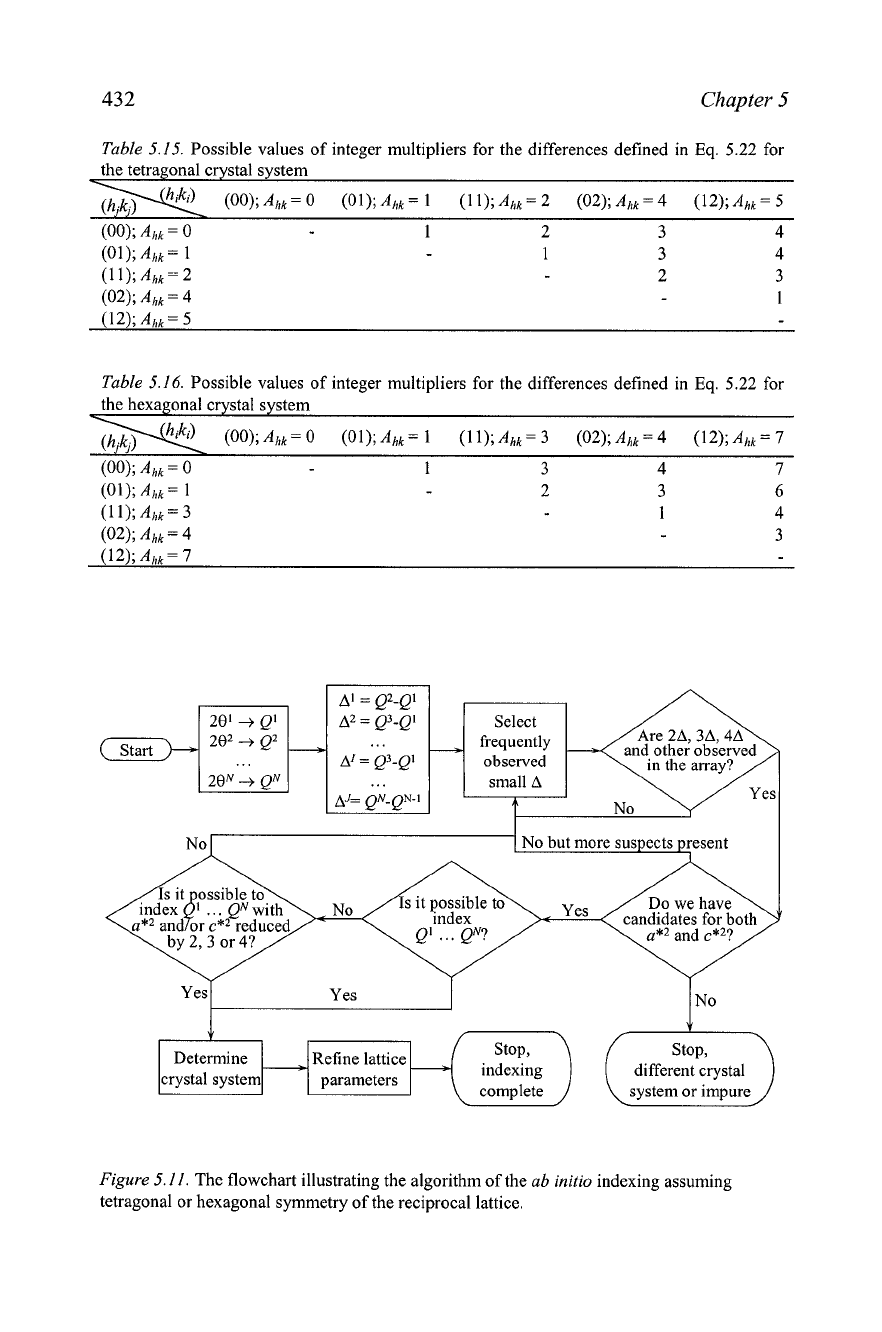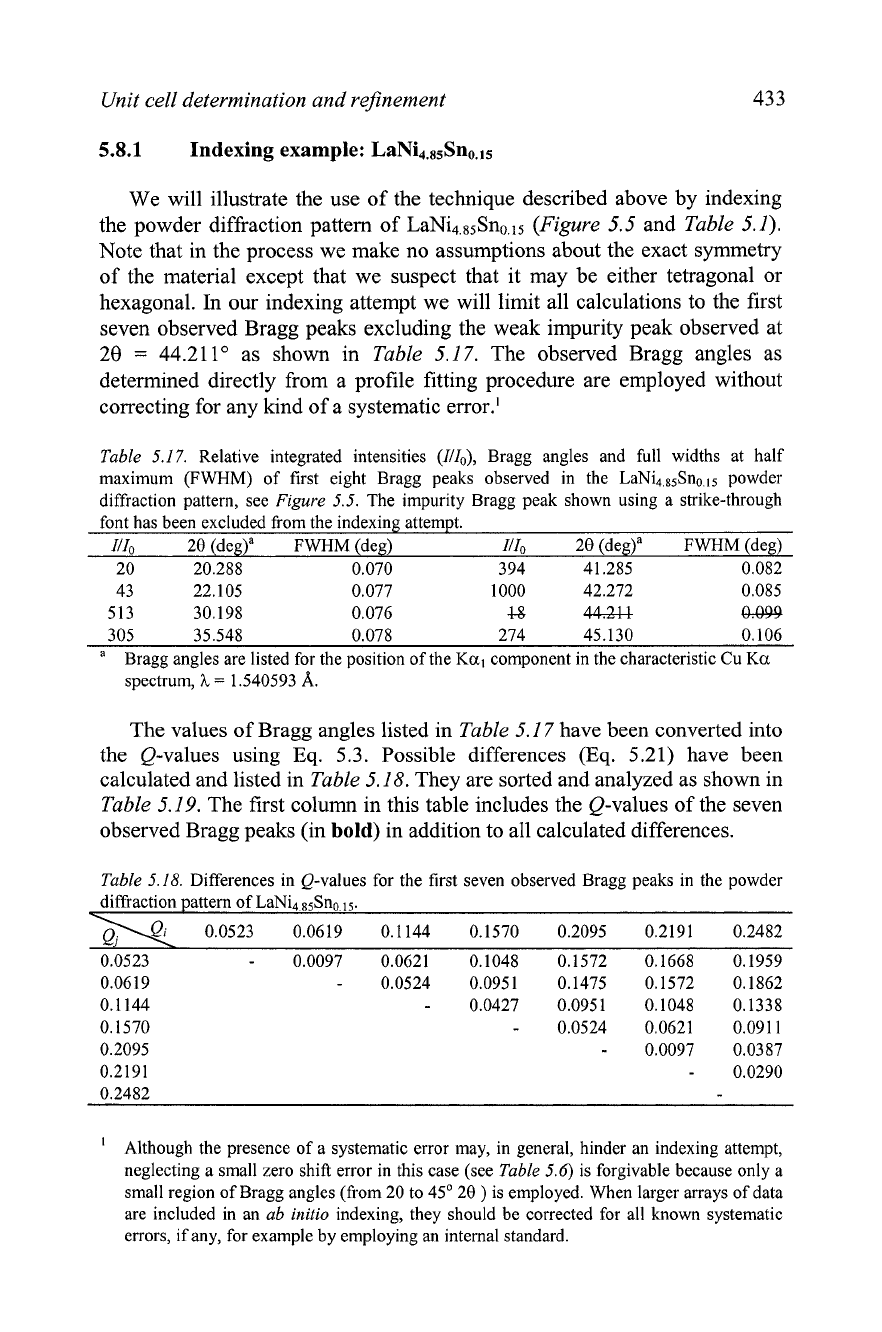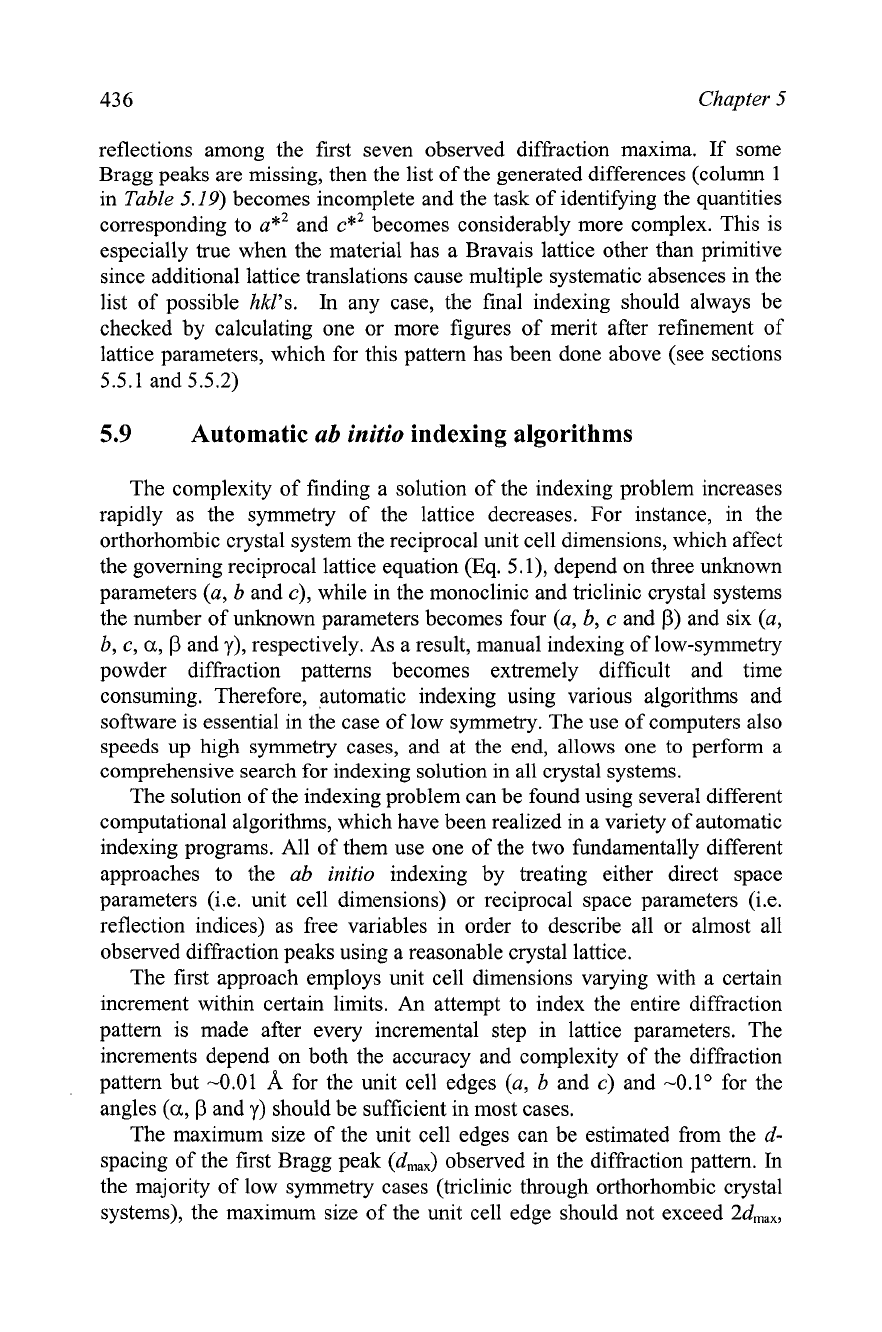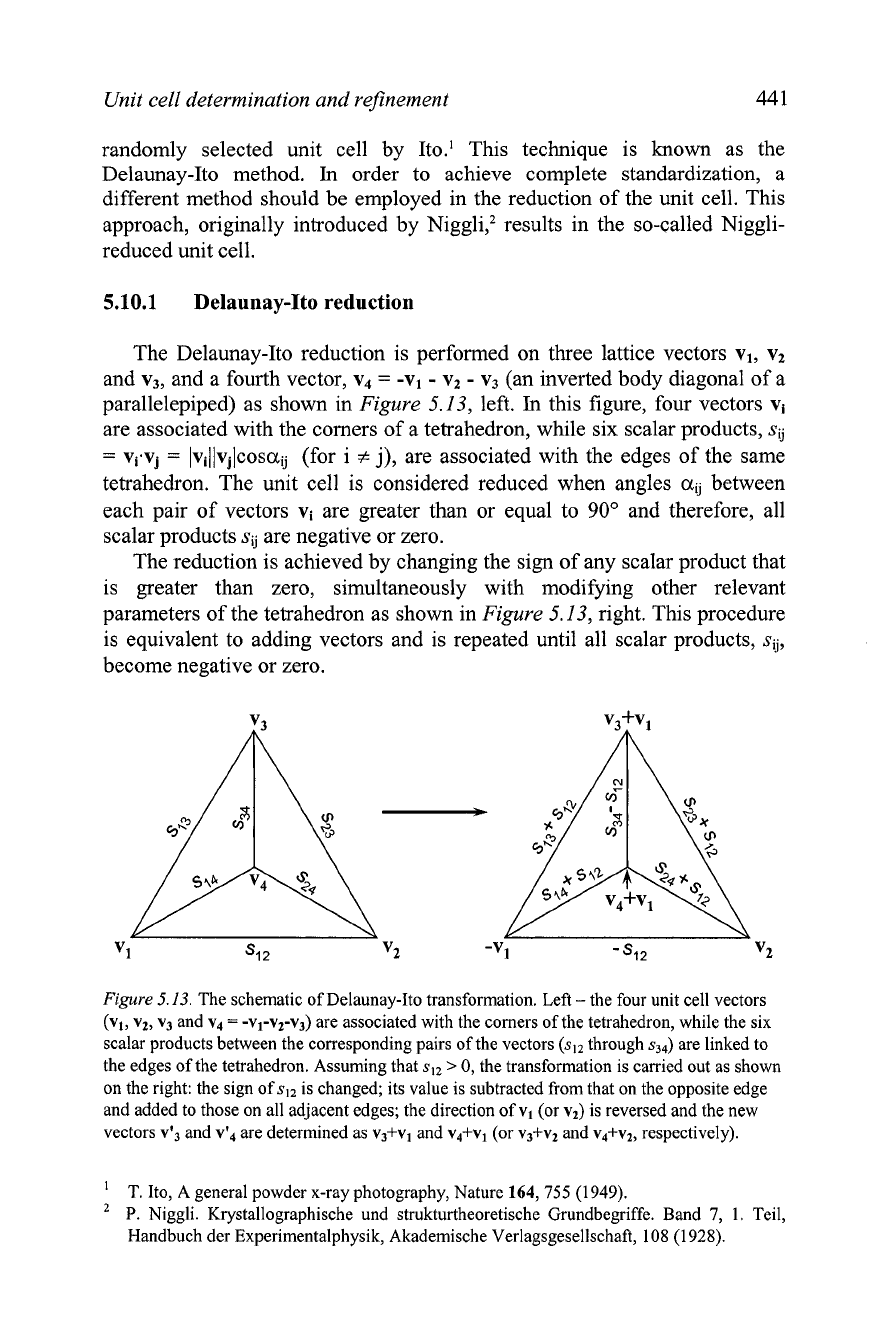Pecharsky V.K., Zavalij P.Y. Fundamentals of Powder Diffraction and Structural Characterization of Materials
Подождите немного. Документ загружается.


432
Chapter
5
Table
5.15.
Possible values of integer multipliers for the differences defined in
Eq.
5.22
for
the tetragonal crystal system
(00);
Ahk
=
0
(01);
dlzk
=
1 (I I);
Ahk
=
2 (02);
Akk
=
4
(12);
Ahk
=
5
(00);
Ahk
=
0
1
2
3
4
(01);
Ahk
=
1 1
3
4
(II);Ahkx2
2
3
(02);
Ahk
=
4
1
(12);
Ahk
=
5
Table
5.16.
Possible values of integer multipliers for the differences defined in
Eq.
5.22
for
the hexagonal crystal system
(00);
Ah,=
0 (01);
Ah,=
1
(1
1)
3
(02);
Ah,=
4
(12);
Akk=
7
(00);
Ahk
=
0 1
3
4
7
(01);
Ahk
=
1 2
3
6
(1 1);
Ahk
=
3
1
4
(02);
Ahk
=
4
3
small
A
It'
NO\
ye
No but more suspects present
Yes Yes
Determine Refine lattice
Stop, stop,
indexing
crystal system parameters
different crystal
complete
Figure
5.11.
The flowchart illustrating the algorithm of the
ab
initio
indexing assuming
tetragonal or hexagonal symmetry of the reciprocal lattice.

Unit cell determination and refinement
433
5.8.1
Indexing example: LaNi4.85Sn0.15
We will illustrate the use of the technique described above by indexing
the powder diffraction pattern of LaNi4.85Sno.ls
(Figure
5.5
and
Table
5.1).
Note that in the process we make no assumptions about the exact symmetry
of the material except that we suspect that it may be either tetragonal or
hexagonal.
In
our indexing attempt we will limit all calculations to the first
seven observed Bragg peaks excluding the weak impurity peak observed at
28
=
44.21
lo
as shown in
Table
5.17.
The observed Bragg angles as
determined directly from a profile fitting procedure are employed without
correcting for any kind of a systematic
err0r.l
Table
5.17.
Relative integrated intensities (Illo), Bragg angles and full widths at half
maximum (FWHM) of first eight Bragg peaks observed in the LaNi4,85Sno.15 powder
diffraction pattern, see
Figure
5.5.
The impurity Bragg peak shown using a strike-through
font has been excluded from the indexing attempt.
Illo
20
(deg)a FWHM (deg) IIIo
20
(deg)a FWHM (deg)
20 20.288 0.070 3 94 41.285 0.082
43 22.105 0.077 1000 42.272 0.085
513 30.198 0.076
4-8
W
0499
305 35.548 0.078 274 45.130 0.106
a
Bragg angles are listed for the position of the
Ka,
component in the characteristic Cu Ka
spectrum,
h
=
1.540593
A.
The values of Bragg angles listed in
Table
5.17
have been converted into
the Q-values using
Eq.
5.3.
Possible differences
(Eq.
5.21)
have been
calculated and listed in
Table
5.18.
They are sorted and analyzed as shown in
Table
5.19.
The first column in this table includes the Q-values of the seven
observed Bragg peaks (in
bold)
in addition to all calculated differences.
Table
5.18.
Differences in Q-values for the first seven observed Bragg peaks in the powder
diffraction pattern of LaNi 85Sno,15.
0.0523 0.0619 0.1144 0.1570 0.2095 0.2191 0.2482
0.0523
-
0.0097 0.0621 0.1048 0.1572 0.1668 0.1959
0.0619
-
0.0524 0.0951 0.1475 0.1572 0.1862
0.1 144
-
0.0427 0.0951 0.1048 0.1338
0.1570
-
0.0524 0.0621 0.0911
0.2095
-
0.0097 0.0387
0.2191
-
0.0290
Although the presence of a systematic error may, in general, hinder an indexing attempt,
neglecting a small zero shift error in this case (see
Table
5.6)
is forgivable because only a
small region of Bragg angles (from
20
to
45' 20
)
is employed. When larger arrays of data
are included in an
ab
initio
indexing, they should be corrected for all known systematic
errors, if any, for example by employing an internal standard.

434
Chapter
5
Table
5.19.
Illustration of the indexing of the first seven Bragg peaks observed in the powder
diffraction pattern of LaNi4,85Sno.15 using Eqs. 5.20 to 5.23.
Qob,,
Diff. Meana ~2~ ~3~ ~4~
a*', c*'
Eq. 5.19
QC~C
hkl
0.0097
0.0097 0.0097 0.0193 0.0290 0.0387
?
0.0290
0.0387
0.0427
0.1047
0.1571
0.2095
la*' 0.0524 010
91?'4fiZm
4c*' 0.2481 002
a
All values in the table are listed with four digits after decimal point but the actual
computations were performed with a better accuracy.
Considering Eqs. 5.22 and 5.23,
Table
5.14 through
Table
5.16, and
Figure
5.11 it is quite clear that all computed differences should be analyzed
for the occurrence of nearly identical small values, which potentially may
correspond to the differences resulting in
a*2
and
c*~
or their whole
multiples. Once the repetitive numbers are found, the next step is to find out
whether or not the array of differences and observed Q-values contains
whole multiples or whole fractions of the found quantities. The tested whole
numbers should be correlated with
Table
5.14 through
Table
5.16.
The initial candidate in the first column of
Table
5.19 is 0.0097, which
occurs twice. The average and the results of its multiplication by
2,
3
and
4
-
the simplest whole numbers that are present in
Table
5.14 through
Table
5.16
-
are shown in columns 2,
3,
4 and
5.
If the computed average
corresponds to either
a*2
or
c*~
then these products should also be often

Unit cell determination and rejnement
435
observed in the array combining both the differences and observed Q-values.
As seen from Table 5.19, this is not the case since only one occurrence of
triple and quadruple multiples of the suspected value are found, and 0.0097
as a candidate for
a*2 or c*~ is dismissed as unsuitable. Furthermore, this
value appears too small because it results in d
z
10 A, which is too large
considering the simplicity of the powder diffraction pattern (Figure 5.5).
The next possibility is 0.0524, which occurs three times for the
differences between pairs of first seven observed Bragg peaks. Not only this
value is itself more frequently occurring than any other smaller quantity
found in the table, but when multiplied by two it yields 0.1047, which occurs
in the array twice
-
these nearly identical numbers are shown in italic.
Testing 0.0524 multiplied by three (0.1571) has three additional occurrences
(all are shown underlined). There is also one occurrence of 4~0.0524
=
0.2095, both are double underlined. Hence, this value seems to be an
excellent candidate for one of the reciprocal lattice parameters. After
consulting Table 5.14 through Table 5.16 it is clear that ~xc*~ is not
expected to be seen but
2~a*~ should be observed quite frequently in both
the tetragonal and hexagonal crystal systems.
Proceeding in a similar fashion with the triple occurrence of the next
small value (the average is 0.0620) we find that the array of differences and
observed Q-values has no occurrences of 2~0.0620
=
0.1241 but both
3~0.0620
=
0.1861 and 4~0.0620
=
,Q..2481
have one occurrence in the table.
Hence, as follows from Table 5.14 the value of 0.0620 is an outstanding
candidate for
c*~.
The next step is to verify whether or not the found candidates for and
c*~ (both are shaded in Table 5.19) result in the complete indexing of the
existing seven Bragg peaks. By using Eq. 5.19, all observed Q-values are
nearly equal to the sums of
~a*~ and CC*~, where
A
and C are whole
numbers, which are listed in the corresponding column in Table 5.19 in bold.
Strictly speaking, the whole diffraction pattern should be indexed following
the same approach, but we leave this to the reader as an exercise.
At this point (or after the whole pattern has been indexed) the analysis of
the observed values of A enables one to establish whether we deal with the
tetragonal or hexagonal crystal systems. As seen in Table 5.19, the whole
multipliers of
a*2 are 1 and
3,
and 3 is only possible in the hexagonal crystal
system for
h
=
1,
k
=
1. After a simple calculation using the average values
of and c*~ listed in Table 5.19 we find approximate values of a and c as
5.046 and 4.015 A, respectively. A least squares refinement of the lattice
parameters using the entire array of indexed Bragg peaks obviously yields
the same lattice parameters as were established before (see Table 5.6).
It is worth noting that the considered example is relatively easy because
first, the lattice is primitive and second, there were no extinct Bragg

Chapter
5
reflections among the first seven observed diffraction maxima. If some
Bragg peaks are missing, then the list of the generated differences (column
1
in Table
5.19)
becomes incomplete and the task of identifying the quantities
corresponding to a*2 and c*~ becomes considerably more complex. This is
especially true when the material has a Bravais lattice other than primitive
since additional lattice translations cause multiple systematic absences in the
list of possible
hkl's.
In
any case, the final indexing should always be
checked by calculating one or more figures of merit after refinement of
lattice parameters, which for this pattern has been done above (see sections
5.5.1 and 5.5.2)
Automatic
ab
initio
indexing algorithms
The complexity of finding a solution of the indexing problem increases
rapidly as the symmetry of the lattice decreases. For instance, in the
orthorhombic crystal system the reciprocal unit cell dimensions, which affect
the governing reciprocal lattice equation
(Eq.
5. l), depend on three unknown
parameters (a, b and
c),
while in the monoclinic and triclinic crystal systems
the number of unknown parameters becomes four (a, b,
c
and p) and six (a,
b, c, a,
p
and
y),
respectively. As a result, manual indexing of low-symmetry
powder diffraction patterns becomes extremely difficult and time
consuming. Therefore, automatic indexing using various algorithms and
software is essential in the case of low symmetry. The use of computers also
speeds up high symmetry cases, and at the end, allows one to perform a
comprehensive search for indexing solution in all crystal systems.
The solution of the indexing problem can be found using several different
computational algorithms, which have been realized in a variety of automatic
indexing programs. All of them use one of the two fundamentally different
approaches to the ab initio indexing by treating either direct space
parameters
(i.e. unit cell dimensions) or reciprocal space parameters (i.e.
reflection indices) as free variables in order to describe all or almost all
observed diffraction peaks using a reasonable crystal lattice.
The first approach employs unit cell dimensions varying with a certain
increment within certain limits.
An
attempt to index the entire diffraction
pattern is made after every incremental step in lattice parameters. The
increments depend on both the accuracy and complexity of the diffraction
pattern but -0.01
A
for the unit cell edges (a, b and c) and -0.1" for the
angles (a,
P
and
y)
should be sufficient in most cases.
The maximum size of the unit cell edges can be estimated from the d-
spacing of the first Bragg peak
(dm,,) observed in the diffraction pattern.
In
the majority of low symmetry cases (triclinic through orthorhombic crystal
systems), the maximum size of the unit cell edge should not exceed 2dm,,,

Unit cell determination and reJinement
43
7
while in the high symmetry cases it should be set at
4
(tetragonallcubic) to 6
(hexagonalltrigonal)
dm,.
When indexing superlattices, in which many
possible reflections are missing, higher limits on the maximum unit cell
dimensions may be required.
This is the simplest but also the slowest indexing method. Obviously,
each crystal system should be tested separately, as the number of free
variables has a critical influence on the computation time. For example, a
total of
4x
lo6 unit cells must be checked assuming a tetragonal or hexagonal
crystal system with unit cell dimensions in the range between 2 and 22
A
using 0.01
A
increment. In a triclinic crystal system, with unit cell edges
between 2 and 12
A
and angles between 90 and 120•‹, a total of 2.7~10'~
combinations should be tested using 0.01 and 0.1" increments,
respectively. Assuming that 1,000,000 unit cells can be tested in 1 second,'
an unrestricted and exhaustive search in the tetragonal or hexagonal case will
take
-4
seconds, but one will have to wait nearly 860 years to test all
possible combinations and see the answer in a triclinic crystal system.
Modem high-speed computers can handle the problem in high symmetry
cases, especially taking into account that other restrictions are applicable.
For example, the maximum expected unit cell volume can be evaluated
from
the density of diffi-action peaks observed in a certain range of Bragg angles.
Furthermore, the following additional restrictions can be imposed: in the
monoclinic crystal system
a
<
c and in the orthorhombic and triclinic crystal
systems a
I
b
I
c, because in these cases the solution is invariant to a
permutation of unit cell edges, except for the need to convert to a standard
setting after the indexing was judged successful.
The most effective is the reciprocal space approach, in which several low
Bragg angle peaks are chosen as a basis set, and then an exhaustive
permutation-based assignment of various combinations of hkl triplets to each
peak fkom the basis set is carried out. Index permutation algorithms are more
complex in realization than direct space algorithms but the former are many
orders of magnitude faster than the latter.' This occurs because the indices of
This assumption is unrealistic using even the most powerful single processor
PC
available
in late 2002. A more rational estimate is between -lo2 and -lo3 unit cells per second for a
well optimized computer code.
*
Consider a triclinic crystal system, where a minimum of six independent Bragg reflections
are required to determine the unit cell. Assuming that the maximum value of each of the
three indices is
1
and recalling that two of them should vary from
-1
to
1
(see
Table
5.7),
a
total number of possible combinations for one Bragg reflection is 3x3~2
-
I
=
17
[the set
(000) cannot be observed and is excluded from the consideration]. In an exhaustive search
without imposing any limitations, a total of
z
2.4~10' combinations among all six
reflections result. This represents about
8
orders
(!)
of magnitude reduction in the
computation time when compared to the mentioned above unrestricted exhaustive search
in direct space. The same example also highlights the critical role of the lowest Bragg

43
8
Chapter
5
low Bragg angle peaks, which are varied, are three relatively small integers.
Today, index permutation is the most common technique used in various
indexing computer programs and it will be discussed in this book.
The reciprocal space indexing can be implemented in several different
ways. Two of them are trial-and-error and zone search methods. The first
one is more efficient in high symmetry crystal systems (from cubic to
orthorhombic) but becomes slow for low symmetry crystal systems
(especially triclinic), while the second method works quite effectively and is
fast with low symmetries (from triclinic to orthorhombic).
5.9.1
Trial-and-error method
The trial-and-error method is based on assigning indices to a minimum
required number of low Bragg angle peaks
-
the so-called basis set. The
minimum number of peaks in the basis set is equal to the number of the
individual unit cell parameters, which varies from 1 to
6,
depending on the
crystal system. The values of indices in the triplets vary between certain pre-
selected minimum and maximum values of h,
k
and I. Each permutation is
followed by the determination of a trial unit cell and by an attempt to index
-10 to 30 consecutive reflections at higher Bragg angles in the resulting unit
cell. Successful solutions, i.e. those, which produce the fully or almost fully
indexed diffraction pattern, are stored along with the computed figure(s) of
merit for further analysis and automatic or manual selection of the best
indexing solution.
The success of this approach is critically dependent on the selection of
the basis set, which generally should contain more Bragg peaks than the
number of the unknown unit cell dimensions. Potential caveats include but
are not limited to the following: the selected basis set contains reciprocal
vectors which are collinear or coplanar (see Figure
5.12);
there is one or
more impurity peak(s) in the basis set or in the list of Bragg peaks included
into the consideration during the indexing attempt, and improper selection of
the minimum and maximum h,
k
and 1 values for index permutations.
The exhaustive permutation technique may be improved by eliminating
collinear reciprocal lattice vectors from the basis set, which can be done by
analysis of the relationships between the observed low Bragg angle
Q-
values. As follows from Eq. 5.1, when two different lld
=
4~
are related to
one another by a whole multiplier, there is a high probability that the two are
collinear, and only the smallest is usually retained in the basis set.
angle reflections in finding a solution of the indexing problem: when the maximum index
to be considered is increased to
2,
the total number of combinations to be tested in an
unrestricted exhaustive search rises to
-1.6x10",
and it becomes
-2.1~10'~
when the
maximum value of index increases to
3.

Unit cell determination and rejkement
Figure
5.12.
The illustration of the two-dimensional lattice with one long
(b*)
and one short
(a*)
reciprocal lattice vectors. If the three lowest Bragg angle peaks (filled circles) are
selected as a basis set for indexing, all of them are collinear and only depend on
a*.
The
remaining two lattice parameters
(b*
and
y*)
cannot be determined from this basis set.
Needless to say, different crystal systems should be tested from the
highest to the lowest symmetry until a satisfactory solution is found. More
often than not, automatic indexing yields multiple solutions, generally with
different figures of merit, and the final decision is still up to the researcher.
5.9.2
Zone search method
Zone search method begins with searching for one-dimensional and two-
dimensional zones and then builds three-dimensional zones using common
rows in two-dimensional lattices. When a three-dimensional zone (lattice) is
found, it is used in an attempt to index all observed Bragg reflections. This
automatic indexing technique is more sophisticated when compared to a
trial-and-error approach, but it is still based on Eq. 5.1. First, the analysis of
numerical relationships between the observed Q-values is made to identify
zones that are invariant with respect to two indices, for example hOO, h10,
OM)
and so on. Second, these are combined to identify zones which are
invariant with respect to one index and, finally zones where all three indices

440
Chapter
5
in the triplets vary independently are found and analyzed. To a certain
extent, zone searching resembles the algorithm described above for the
manual indexing in the tetragonal and hexagonal crystal systems; for
example, zones that are invariant to both
k
and
1
should satisfy Eq. 5.24.
d;,,
=
ha*
+
const
The zone search indexing method does not require an assumption about
the crystal system and therefore, it results in a primitive lattice in most cases.
When the lattice is confirmed by the subsequent indexing of all observed
Bragg peaks, it shall be converted to one of the 14 standard Bravais lattices.
The latter is achieved in a process known as the reduction of the unit cell.
5.10
Unit cell reduction algorithms
Low symmetry unit cells can be selected in a variety of ways regardless
of which method was used to find the unit cell suitable to index the entire
diffraction pattern. For example, in the case of an orthorhombic crystal
system, all three vectors
a,
b,
and c can be permuted; in a monoclinic crystal
system, a, c and
d
=
&(a
+
c) can be switched in a setting with
P
#
90•‹,
while
in a triclinic case, lattice vectors may be selected in a number of different
ways.
In
order to compare and analyze different indexing solutions, the
lattice must be reduced to a certain unique, preferably standard form. It is
usually achieved by applying the following rules (which sometimes are
already incorporated in the indexing process itself by imposing specific
restrictions on the assigned indices):
-
In
the orthorhombic crystal system the unit cell dimensions should be
such that
a
5
b
I
c.
-
In
the monoclinic crystal system,
a
5
c, assuming a standard setting with
b
as the unique axis.
-
In
the triclinic crystal system, the reduction becomes more complicated
due to possible multiple choices of the basis vectors in the lattice.
The first two reduction rules are normally employed only during the
indexing. They usually do not produce a standard choice of the unit cell
since at this stage the space group symmetry, and often even the lattice type,
are not involved. For example, in the orthorhombic space group symmetry
Pnma (a standard setting) the condition
a
I
b
I
c is not necessarily obeyed.
There are two broadly accepted methods of unit cell reduction. One of
them was introduced by Delaunay' and then applied to a transformation of a
'
B.
Delaunay. Neue Darstellung der geometrischen Kristallographie.
Z.
Kristallogr.
84,
109 (1933).

Unit cell determination and refinement
44
1
randomly selected unit cell by 1to.I This technique is known as the
Delaunay-Ito method.
In
order to achieve complete standardization, a
different method should be employed in the reduction of the unit cell. This
approach, originally introduced by Niggli,' results in the so-called Niggli-
reduced unit cell.
5.10.1
Delaunay-Ito reduction
The Delaunay-Ito reduction is performed on three lattice vectors vl, v2
and v3, and a fourth vector, v4
=
-vl
-
v2
-
v3 (an inverted body diagonal of a
parallelepiped) as shown in
Figure
5.13, left.
In
this figure, four vectors vi
are associated with the comers of a tetrahedron, while six scalar products,
so
=
vi.vj
=
lvillvjlcosao (for i
#
j),
are associated with the edges of the same
tetrahedron. The unit cell is considered reduced when angles
ad
between
each pair of vectors vi are greater than or equal to
90'
and therefore, all
scalar products
sij
are negative or zero.
The reduction is achieved by changing the sign of any scalar product that
is greater than zero, simultaneously with modifying other relevant
parameters of the tetrahedron as shown in
Figure
5.13, right. This procedure
is equivalent to adding vectors and is repeated until all scalar products, so,
become negative or zero.
Figure
5.13.
The schematic of Delaunay-Ito transformation. Left
-
the four unit cell vectors
(v,, vz, v3
and
v4
=
-vI-vt-v3)
are associated with the comers of the tetrahedron, while the six
scalar products between the corresponding pairs of the vectors
(s12
through
sS4)
are linked to
the edges of the tetrahedron. Assuming that
s12
>
0,
the transformation is carried out as shown
on the right: the sign of
slz
is changed; its value is subtracted from that on the opposite edge
and added to those on all adjacent edges; the direction of
vl
(or
vz)
is reversed and the new
vectors
vt3
and
vt4
are determined as
v3+vl
and
v4+v1
(or
V3+V2
and
v4+vZ,
respectively).
1
T.
Ito, A general powder x-ray photography, Nature
164,755
(1949).
'
P.
Niggli. Krystallographische und strukturtheoretische Grundbegriffe. Band
7,
1.
Teil,
Handbuch der Experimentalphysik, Akademische Verlagsgesellschafi,
108
(1
928).
